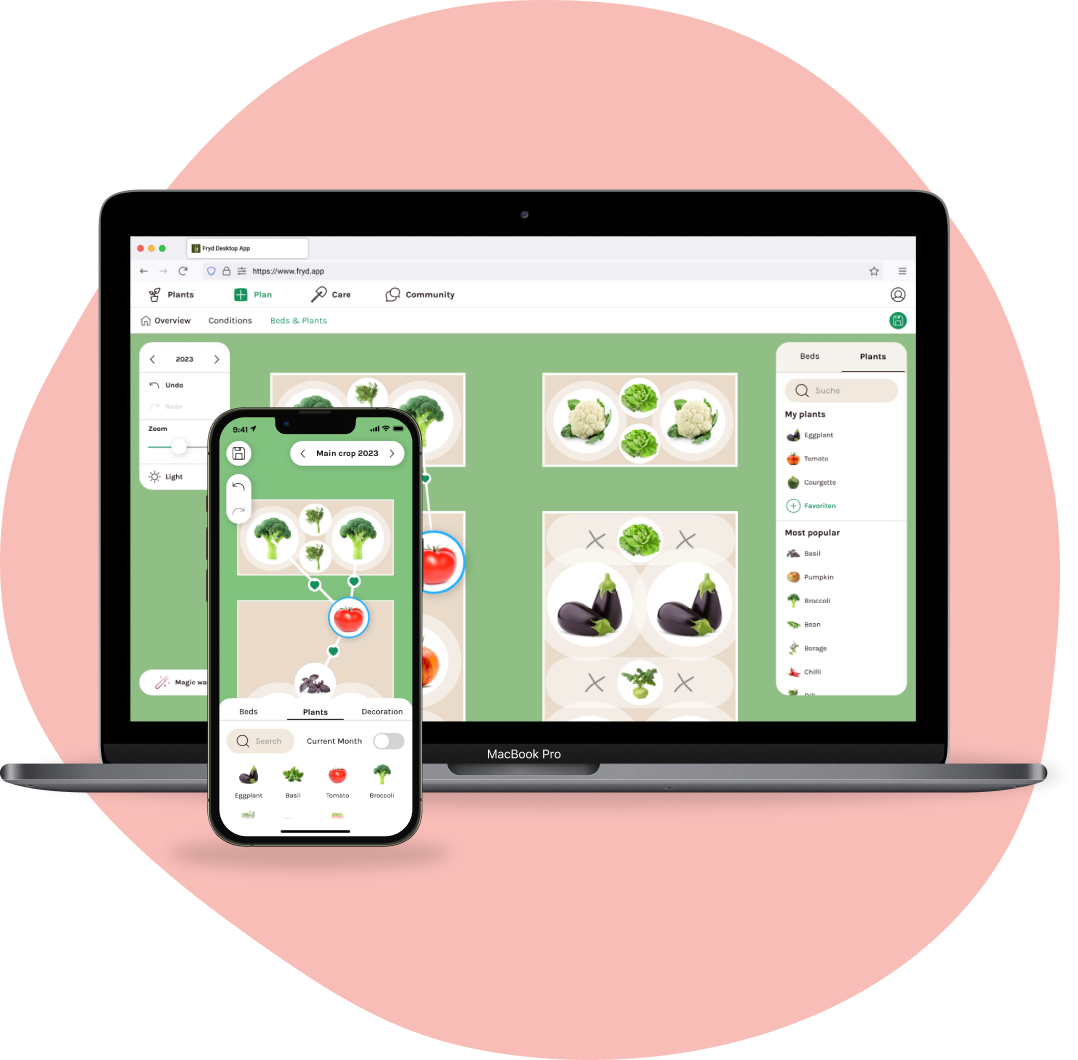Fryd is more than just a planning tool

Planning
Your planting plan is as individual as you are. Perfect it with Fryd according to your wishes, companion plants and effortless crop rotations.

Caring
There is always something to do in the garden. With Fryd, you can keep track of your plants and their specific needs.

Learning
Experience makes for success. Use our plant library, get gardening tips and learn from other gardeners in the community.
Why you should create your planting plan

What makes a good plan?
A vegetable garden is an intricate ecosystem with many moving parts to consider. With the right planning, you can maximize your yield, enrich your soil, and fend off diseases and pests. Let Fryd handle the heavy lifting, crunching the numbers behind the scenes for you.

What is the philosophy behind Fryd?
Modern agriculture often leans on bland monocultures that wear out the soil and invite diseases. We believe there's a better way. With intercropping and permaculture strategies, you can tap into a host of benefits, turning your garden into a thriving haven of biodiversity.
Core benefits

Big screen, big plan
Fryd is a state-of-the-art web application. You can use it as a native app for iOS and Android, but also from a laptop or tablet via a web app. Plan in the comfort of your laptop at home and then take your plan outside with you on your smartphone.

Keep track
We tell you which tasks are pending in your garden. This is based on your seasonal planning combined with live weather data from your bed location. You'll also get useful tips, e.g. on maintaining and improving your soil fertility and fertiliser recommendations.

Giant library
Plants, pests and diseases add up to a huge amount of gardening knowledge - no one can remember it all. You don't have to, thanks to Fryd you always have all the information in your pocket. You can expand our plant database with your own varieties.

The magic wand for your bed
Magically fill up empty spaces in your bed. Our magic wand selects the right plants for you, depending on your individual conditions and the season. Just start with your favourite plants and let us do the rest.
Any Questions Left?
How do you plant a bed properly?
The right planting for a bed depends on your local conditions. This includes climatic conditions, sunlight, wind conditions or the nature of the soil. You should grow plants that feel comfortable in your location. Mixed cultivation is advisable to promote plant growth and avoid pests. Here you can find the Fryd mixed culture table.
When planning your bed, first consider the size: how many vegetables do you want to harvest and how much space and time do you have available? When choosing plants, location factors play a role: do the plants in your bed get enough light and what type of soil (light, medium, heavy) do they prefer? When arranging the plants, pay attention to their space requirements and to good plant neighbourhoods. The Fryd app shows you this immediately when planning your bed.
How do I plant a vegetable patch?
Choose a sunny location for your vegetables if possible. Ideal are rows of beds with a maximum width of 3'11'' and paths at least 1' wide in between. This way you can reach all plants for weeding, mulching or harvesting. A border can help prevent grass or weeds from growing into your bed. The Fryd app makes it easy to plan your garden.
When is the best time to plant a bed?
Ideally, you should plant your bed in early spring or even in the previous autumn (before the ground freezes). This way you can apply compost/soil to your bed over the winter to provide organic material as food for the soil organisms. The season dates of several thousand vegetables can be found in the Fryd-Library.
Which vegetables should not be planted together?
Many plants of the same plant family (e.g. cabbage) in the same place increase the risk of pest infestation. In addition, care should be taken to distribute strong, medium and weak growers locally or to rotate them in time (succession planting/crop rotation). The Fryd app helps you with the optimal arrangement by immediately showing companion plants and antagonistic plants.






